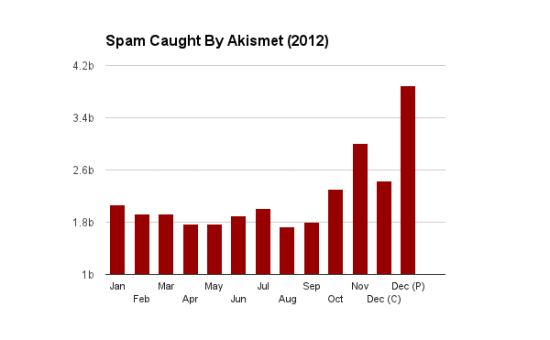It’s that time of the year again.
Time for family members to joyfully gather for the holidays. Time to work on those ill-fated New Year’s resolutions. Time to relax and reflect on the past year and lessons learned.
Here at Akismet, we proudly work year round to protect millions of sites from comment spam. To date, in fact, we have eliminated over 65 billion (yes, with a ‘b’) spam comments, and we saw many interesting — and nasty — things in 2012. Make no mistake about it — spam levels are certainly on the rise.
Akismet saved the web from over 25 billion pieces of spam content this past year alone (and December is not over yet!). Toward the end of the year, specifically, we began seeing alarming and heightened levels of spam. Our daily totals — starting in early December — began topping 120 million spam comments per day, a trend that appears to be continuing into the new year. To add some perspective, these numbers are roughly double what we were seeing in previous months. We also topped the 3 billion spam mark in November:
The chart above contains both current (C) and projected (P) December figures.
More troubling in terms of trends, there has been an unfortunate increase in compromised sites, wikis, and forums. We come across these after a hacker takes over a site, sets up their payload, and proceeds to spam a great number of sites with their malicious links. It is clear that spammers are increasingly willing to use illegal methods, such as hacking and exploiting these vulnerable websites. We have even seen these tactics used to advertise otherwise-reputable and well-known websites, a trend that suggests some marketing firms are outsourcing work to black-hat spammers.
Further noticeable increases in spam include elevated traffic from China, as well as the promotion of Chinese knockoff fashion sites. If you happen to regularly check your spam queue, we’re sure that you’ve seen at least one offer to purchase discount Christian Louboutin shoes or “authentic” Michael Kors purses. Also steadily on the rise has been spam content promoting TV streaming, payday loans, and “Get rich by working from home!” sites and programs. Sure, we have all seen this garbage before, but its recent increase is something to still keep in mind. Here are some example sites, all of which were created on free blog hosts:
Spammers have also taken a liking to the abuse of reputable affiliate and referral programs.Their goal is simple: set up a free blog or site (example shown below), publish oodles of product listings including specific affiliate URLs, and spam the rest of the internet. You may notice that many of these spammers plant their payloads on free site hosts. Luckily, on WordPress.com, Akismet is actively working to combat the creation of these spam sites. We would love to see such integration on other hosts.
A spammer abusing Amazon’s affiliate program. A prominent form of spam in 2012.
Recent streams of human-generated spam are also worth mentioning. These campaigns tend to focus on more difficult targets, such as forums, third-party commenting platforms, and social networks. Such spam can be more difficult to systematically neutralize, which is why Akismet continues to develop and employ refined tactics against it.
Rest assured, we are always hard at work to make sure that any global increase in spam does not mean an unfortunate rise in unwanted comments getting through to your posts or moderation queues. Because we know that you have far more important things to do than sift through trash.
As always, our resolution for the new year is to continue making Akismet better, faster, and more accurate. As spam evolves, so will Akismet. We sincerely thank each and every one of our users for trusting us to defend their sites against the web’s underbelly.
Happy Holidays to you and yours,
Team Akismet








